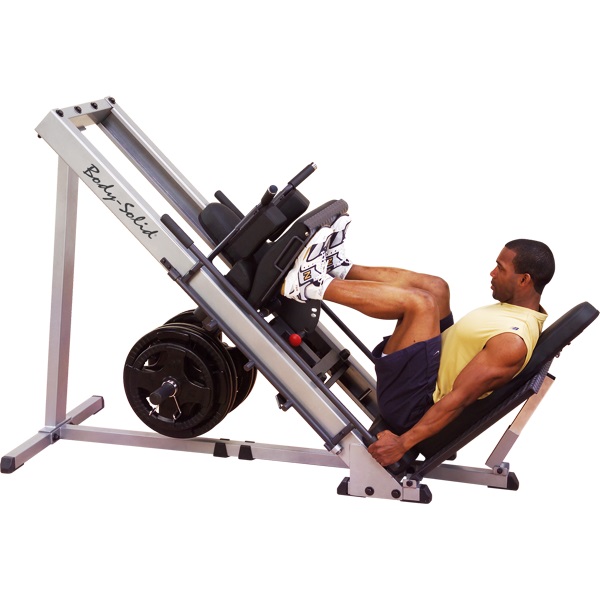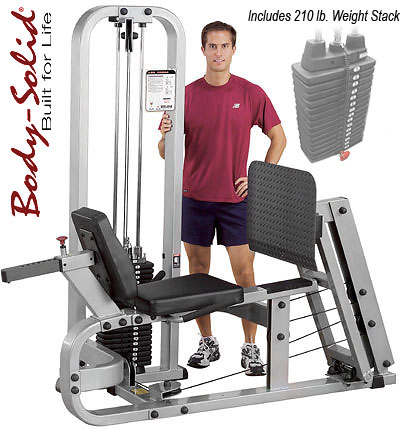What Are the Benefits of a Leg Press Machine?
Leg press machines provide an alternative to the traditional squat by bringing the weight to you. These machine types feature either a 45-degree tilted “sled” that features a platform and moving weight rack or a lever platform that moves horizontally from a seated position. The leg press machine has some distinct advantages over other exercises and machines like it, especially for its muscle targeting purposes. Before you add it to your exercise routine, always check with your physician to ensure you do not have any injuries or medical conditions that would keep you from exercising.
The quadriceps muscles are a group of four muscles in the front of your thighs that help you kick and lift your legs. Although the action of a leg press machine may closely mirror a squat, the leg press machine places greater emphasis on the quadriceps, according to “Muscle & Fitness” magazine. While you utilize less stabilizer muscles, such as the glutes and hamstrings, having your legs in the air and pushing against the platform places greater emphasis on the thighs. When you are really working to build your quadriceps, the leg press machine especially targets these muscles.
Leg press machines are common sites in most gyms. Used as an alternative to squats, lunges and other lower body exercises, leg press machines are popular with bodybuilders and those wishing to lift heavy weights. Using a leg press offers advantages and disadvantages, but correct use of the leg press provides an effective lower body workout.
Leg presses use a guided movement that minimizes your need to balance the weight and coordinate your limbs. This means you are free to concentrate on lifting and lowering the weight — a particular benefit if you want to train using especially heavy loads. Most models of leg press also have range of movement limiters that prevent the weight from falling and squashing you if you fail to complete a repetition. This means that leg presses are especially suitable if you train alone. Leg press machines provide lower back support which may reduce your risk of suffering from a back injury.
Leg Development
Leg presses, a compound exercise, train all of the major leg muscles at once in a natural squatting movement. As a compound -- multi-joint -- exercise, leg presses require all the major muscles of your legs to work in coordination, which works your weakest muscles the most and increases joint stability. Perform leg presses before you do muscle isolation exercises. Compound exercises require greater concentration on form and should not be performed with fatigued muscles.
Strength and Size
Exercising with the leg press machine recruits back muscles as well as leg and gluteal muscles to lift the weight. By using compound muscles, you can lift more weight and experience less fatigue than when you perform weight-lifting exercises that put more strain on your back. Because of increased capacity for exercise, you can gain strength and muscle size in a relatively short period of time.
Variation

The leg-press machine uses multiple stances to achieve greater variation in training. With your feet near the top of the sled, you can focus on your glutes and hamstrings. With your feet at the bottom of the sled, you can focus on your quadriceps. By lowering your feet until your heels are off the sled, you can exercise your calf muscles.
Safety
The leg press machine offers numerous safety benefits. With the user in a seated position, there is no worry about being able to balance the weight. Most leg presses are designed with safety catches in place so there is no need for a spotter.
Ease of Use
Because the leg press is a relatively simple machine with few moving parts, most beginners can use the leg press correctly following brief instructions from a trainer. Unlike more complicated free weight exercises, which have a longer learning curve, a beginner can get the benefits of a leg press in their first workout.
Warm Up and Stretch
Walk, ride a bike or do calisthenics to warm up your muscles and prevent injury from leg-press exercises. Five to 10 minutes is enough time to warm up and increase flexibility in your muscles and lubrication in your joints. After your workout, do leg stretches, such as quadricep stretches -- pulling your heel up to your buttock and holding for 10 to 30 seconds -- or hamstring stretches -- placing your hands against a wall and stepping one foot backward, behind the other. As you lean your upper body toward the wall, the hamstrings of the back leg get a stretch. Repeat on the other side.